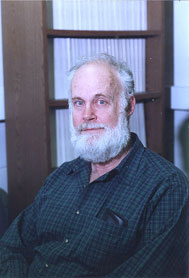Michael F. A'Hearn
| Mike's Bio | BBC Interview | |
| Up Close and Personal | UMD Interview | |
| Listen to Mike's interview with the BBC | ||

Captain Astronomy
Where would Dr Michael A'Hearn be, if he weren't the principal investigator of NASA's Deep Impact mission, and a professor of astronomy at the University of Maryland? Sailing the high seas, "probably a captain of the merchant marine," says this white-bearded astronomer, who keeps his boat and his commercial coast guard license at home in Maryland.
Even on one of his trips up the Atlantic coast to New England, he can't see as many stars as he can with a professional telescope up on a good mountaintop.
"By training and disposition, I'm a traditional astronomer," he says. He studied physics in college, and then took his PhD in astronomy. It's really the practical side of physics that he likes, the part that's applicable to things we can see and touch. He now studies the composition of comets, looking at almost every wavelength of the light they reflect or emit, to get clues about what comets are made of.
"I'm trying to solve the mystery of what conditions were like in the early solar system, how things got made," he says. "My tools are comets and asteroids."
One of his most exciting moments was finding molecules that he did not expect to see in comets. He found out by looking at light reflected off comet Hyakutake how water breaks down in a comet. He unexpectedly stumbled on a part of a molecule in a particular configuration, which they had observed in the lab, but never looked for in comets. Some of the molecules they saw turned out to be water in this special configuration.
Mike is currently writing a paper showing how the mixture of elements composing a comet change as the comet's gases expand. Interesting projects like this, combined with the discoveries he has made balance out the disappointment of trips planned to observe a comet made fruitless by bad weather.
On the whole, though, he wouldn't change his job at all. Coming in every day and overseeing the Deep Impact mission gets him out of bed in the morning, "that plus not having said no to a lot of national committees," he adds. He works on a baker's dozen of astronomical boards, journals and panels he works on, after his teaching, research and principal investigator duties are done.
Now that he's steering the Deep Impact ship through the unknown waters of space, he thinks it's important that everyone who enjoys doing science research get into the field. "The Discovery program has been an important change in space science," he says. It allows missions to be driven by the principal investigator's science goals, rather than by an institution's needs. And more science gets done because the missions have tight budget constraints.
by Martha Heil, Jet Propulsion Laboratory











